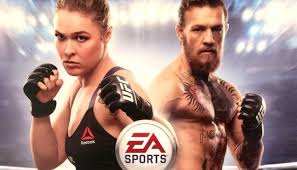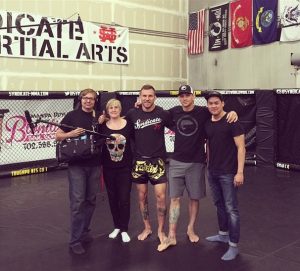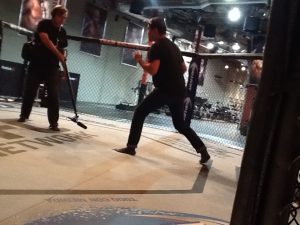“The sound design is legendary in this game. The sound design is legendary.” (Hip Hop Gamer)

It’s been 7 months since EA Sports UFC 2 was released, so I thought it was about time I wrote a bit about the process of my sound design work on the project, especially considering the many positive comments across multiple reviews of the game.
Having worked on UFC 1 for a year, I was delighted to be asked back for another contract to take care of all the sound effects design – from the punches, kicks and Foley to the mat impacts, fighter vocalizations, gym ambiences and UI sound effects.
Working on the first iteration of a title often means spending large amounts of time working out systems and ironing out kinks associated with pipelines and tools and UFC1 was no exception. We had a solid team on the project, led by Audio Director Ted Conley and producer Freddy Ouano. The UFC1 mandate, from a presentation point of view, was to make the game sound as close to the television experience as possible. As such, the greatest priority was given to the commentary and the crowds, with many other sonic elements being deliberately underplayed.
PUNCHES, KNEES and KICKS!
When I came back for UFC2, I was very happy to learn my brief was to move away from the ‘realism’ of UFC 1 and add some punch to the punches, as it were. For the strikes, I focused on finding a balance between the often underwhelming or sometimes inaudible impact sounds from the TV presentation and the over-the-top hyper-real impacts heard in the likes of Street Fighter games. I wanted to make the striking game gratifying but not cartoony.
I was lucky enough to be provided with a huge session of Foley recordings that Ted Conley had directed of legendary Warner Brothers Foley artist John Roesch. I thought about what the sound of a hand, foot or knee connecting with different parts of the body would ‘feel’ like, and split my impacts up into different categories such as “slappy”, “thuddy”, “light”, “meaty”, “boney” and so on. Using the Warner Brothers sessions as the backbone, I set about editing these recordings, usually layering multiple elements as well as sometimes using commercial library sounds as additional support. A kick to the stomach would have some ‘slap’ of the foot connecting with the flesh, with some ‘meat’ for the thud of the body, and a slight ‘flappiness’ to try to reflect guttural nature of a person’s stomach.
There are a huge number of different strike types in MMA, and I had to create an event for each of those strikes connecting with each of the different body parts. The resulting patch in our audio engine (‘Harmony’) consisted of hundreds of different combinations.
As with any aspect of game development, iteration is the key. The first stage is to get the initial pass of sounds in the game, which in itself is often a long-winded process figuring out the best technical method to move forward with. Once the sounds are implemented, it’s a case of playing the game over and over and tweaking the audio until there is a seamless connection with what you are seeing and hearing, and most importantly feeling. Yes, emotions are a huge part of game audio.
I decided that for ‘Critical Strikes’ I would up the ante a bit, and move a little towards the “hyper-real” nature of other, more cartoony fighting games. I didn’t push this too far, but for these kicks and punches, I layered up some more traditional “Hollywood” sounding punches to add even more beef to the strikes I had already created. Because Critical Strikes were reserved for key game-changing moments, those strikes were instantly gratifying, both visually and sonically. Of course, these moments were not sold by impact sound effects alone, but also by the extremely carefully crafted crowd responses (led by Ted Conley and his ‘crowd team’) and realistic reactionary commentary, led by Terry Calico (and his ‘commentary team’). The overall audio presentation really came together well in UFC2.
THE REVIEWERS REACTIONS
I wanted the player to feel the pain, and I am happy to say I think I achieved that, based on the shout-outs given to the impact sound effects in several reviews:
“Dramatic music, roaring crowds, rattling sounds of fist, elbow, foot and knee hitting flesh. It’s all present and correct.” (Xbox Achievements)
“Punches, kicks and knockouts arrive with palpable force and sound to match” (Polygon)
“The sound of strikes feels right” (Solid Altair Game Changer)
“the snap sound of kicks as your shin slaps an opponent’s thigh is spot on, the thud of punches and sometimes the grunt your fighter makes as he/she lunges in for an attack are all good” (4OneGaming)
“A special mention must also be made of the sound design. When you actually connect a punch or a kick, you can really feel it and most of that is down to the audio. When you properly boot someone in the face, the corresponding click, as well as the cheer from the crowd, makes you cringe. It cannot be knocked.” (WCCFtech)
“The sounds of leather hitting flesh or bodies getting slammed on the mat are crisp, and the commentary from Mike Goldberg and Joe Rogan sounds as natural as it does in every TV broadcast and pay-per-view event. Things go into overdrive once you land a killer blow. The deep thud of a hard hit makes everything go frantic, as the crowd gets whipped into a frenzy and both commentators become just as excited as the fans. These are the moments that more casual MMA fans will recognize, and hearing that executed perfectly is the hallmark of the audio portion of the game.” (Worth Playing)
“Coupled with the roaring crows, and riveting sounds of each blow you deal to your opponent—it all adds up to reaffirm EA Sports UFC 2 as the most realistic UFC game available.” (Plug-in Blog – Best Buy)
“Once you’re into the fight, crowd sounds and chants are authentic without getting repetitive and punches and kicks land with a hefty crunch.” (The Gaming Review)
“The thick thromb of a kick slamming into a fatty’s gut resounds through the mics and when a takedown ends in a body slam you can hear the entire cage shake and groan.” (ACG)
FIGHTER GRUNTS!
Of course, the sound effects design for this game was not just about the punches and kicks. For anyone who knows mixed martial arts, what’s very interesting is that vocally many fighters huff and puff (or “whiff”) an enormous amount during training, but are often largely silent during an actual fight.
I spent a lot of time watching different fights from all the fighters in the game, and rating them on a scale of 1 – 4 as to how noisy they were. Some were silent even when giving or taking a pounding, others were really noisy right out the gate. With my ‘noisiness rating’ I was able to tune how noisy each fighter is vocally, remaining as true as possible to the actual fighters. I was also careful not to add vocalizations for every strike, rather key strikes that would justify an exertion, again all guided by watching hours of real footage. I was sure to ramp up the vocalizations when they were in a training gym as opposed to an actual fight.
For UFC 1, I had recorded some stunt actors as well as UFC fighters Sarah Kaufman and Jason Day for their vocalizations. Considering we had many more fighters in UFC2, this wasn’t going to be enough for variation, so I further categorized the different tones and sounds the fighters made (some were “ooshy”, some “ishy”, some “hah”, others “huh”, some round, deep, some lighter). We spent a day at Levy Production Group in Las Vegas recording several MMA fighters whiff and grunt while going through a number of jabs, uppercuts, knees and kicks in the studio. It was pretty cool directing the fighters to “do their thing”, balancing the challenge of needing them to move to get the right sound with them not making too much movement noise on the mic!
FOLEY
A big game design focus for UFC2 was to improve the ground game, and I was happy to contribute sonically to this by utilizing more of the Warner Brothers Foley recordings for the body contact sounds. Another giant patch was made in Harmony, covering foot scuffs on the mat, grappling, shorts rustles, flesh scrapes and so on. Implementing these audio events was a long, often tedious task of ‘tagging’ thousands of short animations – I was very lucky to be able to offload a lot of this tagging to other members of the audio team. While it would have been great to implement this procedurally, we did not have the time and resources from an engineering point of view to realize this, so manual tagging was the only way to go. Tagging is a fun job, as it’s very rewarding to hear how careful placement of audio events can really bring an animation to life. It’s often remarkable how an addition of an extra sound or two can make a huge difference, but the sheer number of animations means it’s a task that can go on for weeks, so it’s definitely a good job to pass over to more junior members of the team, where you can help guide them to make nuanced choices and improve their critical listening skills.
THE OCTAGON AND GYM AMBIENCES
“Mats rumble from slams” (PlayStation Universe)
“Impact from fighters landing on the canvas after a knockdown/knockout sounds absolutely brutal – in a good way! It really brings home how hard and impactful your punch or kick to the head was to your opposite number” (The Koalition)
Another hugely important piece was getting the sound of the Octagon right. Ted had really wanted to hear an almost bass drum-like resonance to some of the mat impacts, but this was surprisingly hard to achieve using either library or the Warner Brothers Foley content. I also found it challenging to realistically recreate the sound of the cage rattles. There was only one thing for it – record an actual Octagon.
I had suggested looking for an MMA gym in or around Vancouver to record. Our Audio and Presentation Producer Freddy Ouano took it a step further though. He had already had several meetings with various UFC representatives and trainers in Vegas, so his contacts meant we were lucky enough to be able to rent Syndicate Gym in Vegas for a days recording.
I made a list of cues we needed to grab – slams against the mat, slams against the cage, grappling, close ups of training with pads and bags and so on. Freddy and I had the pleasure of directing one of the gyms owners and trainer John Wood and UFC fighter Mike Pyle (I had also recorded Mike’s vocalizations at Levy Productions on the same trip).

Pictured above: John Pitron, Lin Gardiner, John Wood, Mike Pyle, Freddy Ouano
We also utilized our time at Syndicate to record some general quad ambiences which I used in the gyms in Career Mode. We placed two stereo pairs of Sennheiser MKH 416’s in the centre of the gym and let the Sound Devices recorder roll for the full day – that was a lot of editing when I got back to my audio suite!
We had an awesome day’s recording at Syndicate, but there was one thing I couldn’t quite get – the sound of a foot scuff on the mat. The octagon at Syndicate had gym mats and not the fabric surface that I needed. We were working with recording engineer John Pitron from Stickman Sound, the company also responsible for The Ultimate Fighter TV show. Luckily for us, the show was wrapping for the season that day, and we were granted permission to cross town to the studio where it was being shot, and spend a while recording on an actual UFC Octagon before they tore down the mics! I was able to get the final pieces of the puzzle I was after – genuine mat scuffs, footsteps, more cage rattles and some killer slams on a real UFC Octagon!
Here’s a photo of recordist John and producer Freddy capturing those much-sought-after foot scuffs:

This two day recording trip to Las Vegas was like recording gold and really gave me a wealth of material to work with.
The Mic setup we used at Syndicate for the Octagon was a mirror of the mic setup for The Ultimate Fighter:
4 Sennheiser MKH 70’s set up in a quad over the center of the octagon.
1 stereo pair of Sennheiser MKH 416’s placed above the center of the octagon.
An AKG D112 and a Shure Beta 52 placed under the octagon.
Stickman found that with the 70s placed in the quad pattern, they are able to pick up most of the octagon sounds as the 70s have such a long throw. They get good punch sounds, feet noises and general fighting sounds with those mics. The 416s is a trick picked up from HBO boxing. They place a stereo pair in the centre to get a stereo perspective during the fights. The D112 and Beta 52 under the octagon get all of the really good stomp sounds and good bass sounds when someone gets slammed down on the octagon.
John chose a Sanken CS3e for the close-up “run and gun” recordings, because he likes a medium throw shotgun microphone with a very narrow pick up pattern to reject as much outside noise as possible.
CONCLUSION
Prior to getting hired for UFC1, I admit to knowing nothing about the sport. I had seen it on TV screens in the background in bars, and usually jokingly dismissed it as a bit of homoerotic posturing. But when I started on the project and began to research and watch fights, I realized very soon that this was a sport that was quite fascinating. The UFC had worked hard to clean up the image of what was once more of a violent free for all, to a sport that is an interesting melange of several martial arts, with strict rules and codes of conduct. Of course, this sport has it’s ‘personalities’ and big egos, but having met a number of ‘regular’ UFC fighters, I can say that this is a sport that draws in athletes (male and female) from all walks of life, and the handful of fighters I met were fun, polite, respectful and above all absolutely dedicated to their passion.
I loved working at EA Burnaby on this title, especially with my friend and audio “mad scientist” Ted Conley. Ted is an amazing audio lead – he picks people he trusts and steps back to let them get on with it, never micro managing, always open to discussing ways to improve content and pipelines, and always constructive in his feedback. He did a great job on the mix of the game, to the point that the mix even got called out in some reviews, which is pretty rare for game reviews. It was also amazing to have the privilege of working with two outstanding audio programmers Melissa Gilliam and Steven Scherrelies – without those two we couldn’t have done half the things we did. The whole crew on the project deserve a shout out: Ted Conley, Terry Calico, Freddy Ouano, Yours Truly, Cesar Beretta, Myung Kim, Jamie Bell, Kieran Fitzpatrick, Matt Ryan, Daejin Kim, Dorian Pareis. By the time the game was released, I had moved on to my new adventure on a totally different type of project in a different studio, but it was an honour to get stuck into a sports game like this, really fun to have the opportunity to work on the ‘v2’ of a project, and really awesome to get the call from Ted excited about all the rave reviews the audio was getting. All the attention to detail seemingly paid off, which is as much as any sound designer can ask for!






